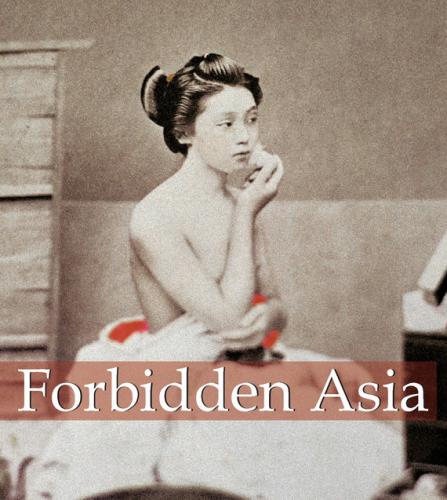Forbidden Asia. Hans-Jürgen Döpp
-Jürgen Döpp
Forbidden Asia
“She dusts the pillow, perfumes her red hairnet, Swivels the lamp and slips off her clothes. Her maids know the night will be long But no call means they may go home.”
© Confidential Concepts, worldwide, USA
© Parkstone Press International, New York, USA
Image-Bar www.image-bar.com
Main Artists
Anonymous Master of the Kangxi Period
Anonymous Master of the Kangxi Period
Eisen, Keisai
Eisho, Chokosai
Harunobu, Suzuki
Harunobu, Suzuki
Hokusai, Katsushika
Hokusai, Katsushika
Hokusai, Katsushika
Koryusai, Isoda
Koryusai, Isoda
Kunisada, Utagawa
Mei, Xu
Morohira, Hishikawa
Pupil of Utagawa Kuniyoshi
Shun’ei, Katsukawa
Utamaro, Kitagawa
Bound happiness – Chinese eroticism
The aim of Taoist art and culture was to reach a state of harmony that would lead Man, confronted by a chaotic universe, towards a new serenity. In this spiritual context, love represented for the Chinese a force which was supposed to unite sky and earth in balance and maintain the reproductive cycle of nature.
Illustrations from Qinglou Duoying, published as ‘Selected Scenes from Verduous Towers’
Colour woodcuts from an album, late Ming period
(first half of the 17th century), 26 × 25 cm
The Muban Foundation Collection
‘Verduous Towers’ is the veiled Ming term for a brothel
Eroticism thus became an art of living and formed an integral part of religion (to the extent that such western notions can be applied to philosophical thought of this kind).
Taoist religion assumes that pleasure and love are pure.
Anonymous Master of the Kangxi period
(1662–1722)
Painting on silk from an 8-page album, 39.5 × 55.5 cm
‘In order to gain some understanding of Chinese eroticism,’ writes Etiemble, a great connoisseur of Chinese art, ‘we need to distance ourselves from the notion of sin and the duality between the corrupt body and the holy spirit.’ This ideology lies at the very base of Christianity. Erotic Chinese art reflects the extent to which we are ‘morally corrupt’ and ‘full of prejudices’.
Painting on Silk from an 8-page album, Kangxi period
Xu Mei, (1662–1722)
Silk, 42.5 × 74.5 cm
Courtesy: Collection Guy & Myriam
Ullens Foundation, Switzerland
The Yin-Yang pairing introduces us directly into the world of Chinese eroticism: The ‘path of Yin and Yang’ signifies nothing less than the sexual act itself. One of the best-known sayings of ancient Chinese philosophy, ‘Yi yin yi yang cheh we tao’ (‘On the one side yin, on the other yang, this is the essence of Tao’) indicates the fact that sex between a man and a woman expresses the same harmony as the changes between day and night, or summer and winter. Sex symbolises the order of the world, the moral order, while our culture stigmatises it as evil.
Anonymous Master of the Kangxi period
(1662–1722)
Painting on silk from an 8-page album, 39.5 × 55.5 cm
In this sense, master Tung-huan wrote in his Art of Love, ‘Man is the most sublime creature under the skies.
Scene from Rouputuan, ‘The Prayer Mat of Flesh’
18th century
Painting on paper, 37.5 × 37.5 cm
Nothing which he enjoys can be compared to the act of sexual union. Formulated according to the harmony between the sky and the earth, it rules Yin and dominates Yang. Those who understand the sense of these words can preserve their essence and prolong their life. Those who do not grasp their true significance are heading towards their doom.’
Chinese Wedding Tablet
18th century
Painting on silk and appliqué relief mosaic pictures made from different coloured jade, mother-of-pearl, and ivory
They serve to instruct newly married couples
The split in the Universe between Yin and Yang is all the more important because these two inseparable principles mutually influence each other.
We know of a great many Chinese manuals whose purpose was to provide an education in the art of love-making for young couples; this education would cover desire, morality, and religion. In these texts, the sexual act is always referred to metaphorically, with terms such as ‘the war of flowers’, ‘lighting the great candle’, or ‘games of cloud and rain’.
Painting on Porcelain Vase (detail)
18th century, 11.3 × 13 cm
Painting on Silk
18th century, 31.5 × 34 cm
They are also full of images referring to various sexual positions:
– unfurling silk
– the curled-up dragon
– the union of kingfishers
– fluttering butterflies
– bamboo stalks at the altar
– the pair of dancing phoenixes
– the galloping tournament horse
– the leap of the white tiger
– cat and mouse in the same hole
Box Featuring Erotic Images
Painted on glass
In Chinese aesthetics, nothing is ever named directly and without beating about the bush. Instead, things are referred to obliquely, and any transgression of this tradition is considered vulgar. Even the European notion of ‘eroticism’ would be too direct. They would prefer to substitute the term ‘the idea
